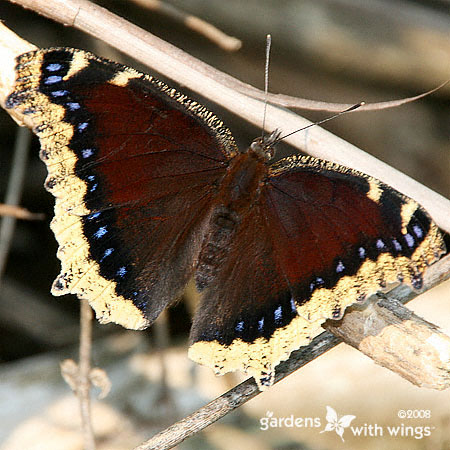by Regina Cutter Edwards
What happens to all beautiful butterflies as the days get shorter and the temperatures cooler? As the days get colder, this is a common question in the mid to upper portions of the United States. The answer can be brief; most are still there. But for the curious mind, that does not answer the critical and exciting question of “where?”
Understanding the Butterfly Life Cycle
The critical component to understanding the answer to this popular question is understanding the butterfly’s life cycle. There are four stages: egg, larva (caterpillar), pupa (chrysalis), and adult. Read the ‘The Mysteries of Life’ article for more detailed information regarding the butterfly’s life stages. Let us talk about the cold for those already familiar with the life cycle.

Butterflies are cold-blooded, which means they do not regulate their body temperature; they depend on their environment. A butterfly can fly when temperatures are around 60-100°F, but its body temperature must be at least 85°F. To increase their body temperatures, butterflies often bask in the sun. They must find a safe place to overwinter when outside temperatures get colder in the fall. It is when they seem to disappear. So where do they go?
Do Butterflies Hibernate or Migrate?
Many butterflies, such as the Common Buckeye, Painted Lady, Red Admiral, and Cloudless Sulphur migrate each year to warmer locations. The Monarch butterfly completes the most popular and furthest migration of all the butterflies, reaching up to 2000 miles. These migrations are fascinating and not completely understood; please refer to the ‘A Rhythm in Nature’ article for more information.

What is Diapause in Butterflies?
Diapause is a form of hibernation in the insect world. It occurs when the juvenile hormone, which is triggered by light and/or temperature, decreases in the butterfly. The butterfly enters an inactive state, metabolism slows down, and feeding and reproductive behavior cease. Diapause occurs on a predictable cycle and begins before unfavorable environmental conditions, such as chilly weather. The butterfly will come out of diapause when environmental conditions again become favorable. The Monarch butterfly, although it migrates, stays in a diapause state while in Mexico overwintering.
Where do Hibernating Butterflies go in the Winter?
In the adult stage of their life cycle, butterflies that do not migrate will stay in the same location throughout winter. They will find a small crack or crevice in a rock, tree, or building to squeeze into for protection from wind and predators. To prevent freezing, insects produce an anti-freeze compound in their bodies that prevents ice from forming in their hemolymph (insect blood). On a sunny day, if their body temperature gets warm enough, it is possible to see a butterfly in the middle of winter. The Mourning Cloak, Question Mark, and Comma are a few butterflies that will stick around during winter. Overwintering butterflies are usually angle-winged butterflies and are a dark color.
How do Butterfly Chrysalises Overwinter?
Many butterflies, such as swallowtails, some whites, and sulphurs, overwinter in the pupa stage. They are usually the species that feed on woody host plants, and the chrysalises have a silk harness that is attached in the middle of the chrysalis to the twig. This extra silk thread is for additional support from the winter winds. It is also common to find a chrysalis underneath leaf litter, so be careful when cleaning the flower beds in the spring.
How do Butterfly Caterpillars Overwinter
Some butterflies can make it through winter while in the larval stage.l stage. The Viceroy butterfly, for example, will overwinter in a curled-up leaf of the host plant. The caterpillar enters diapause, and the body functions slow down, and the caterpillar ceases to eat until favorable environmental conditions return. The Baltimore Checkerspot is another butterfly that overwinters as a caterpillar; it hibernates at the base of plants in leaf litter.
What Happens to Butterfly Eggs in the Winter?
The Banded Hairstreak is one type of butterfly that overwinters as an egg. The eggs are laid on the leaves of their host plants (i.e., Hickory, Walnut, or Oak) and will hatch in the spring. The Poling’s Hairstreak is a butterfly that lays eggs singly on twigs and overwinters. The Karner Blue butterfly is another butterfly that overwinters as an egg. Not many butterflies go through winter as an egg but it does happen.
Life Cycle of Butterflies
The life cycle of butterflies is fantastic, and butterflies have the ability to survive winter in all stages of their life. In winter, when you are walking outside in the cold, think of the lovely butterflies hibernating nearby and waiting for the warm weather. It will give you another great reason to look forward to spring.
Next Up…












